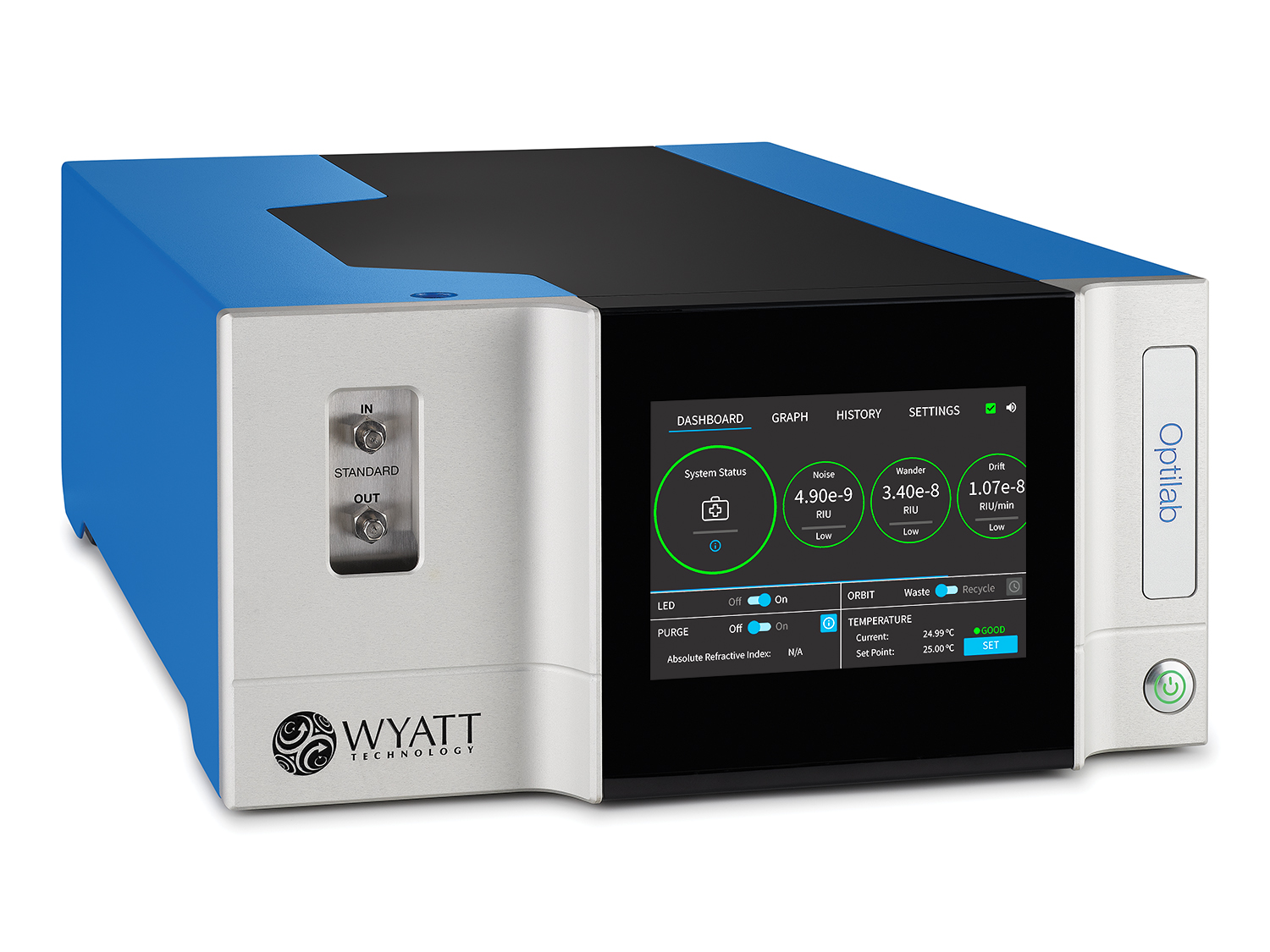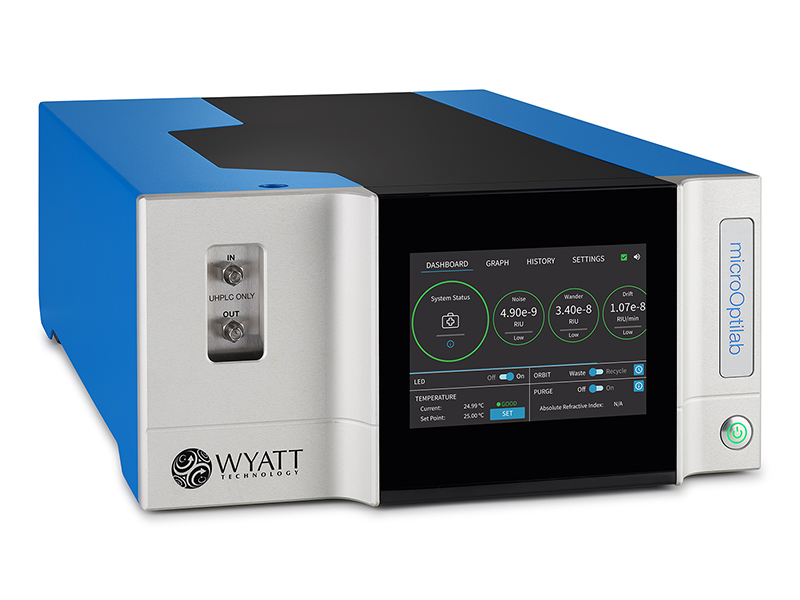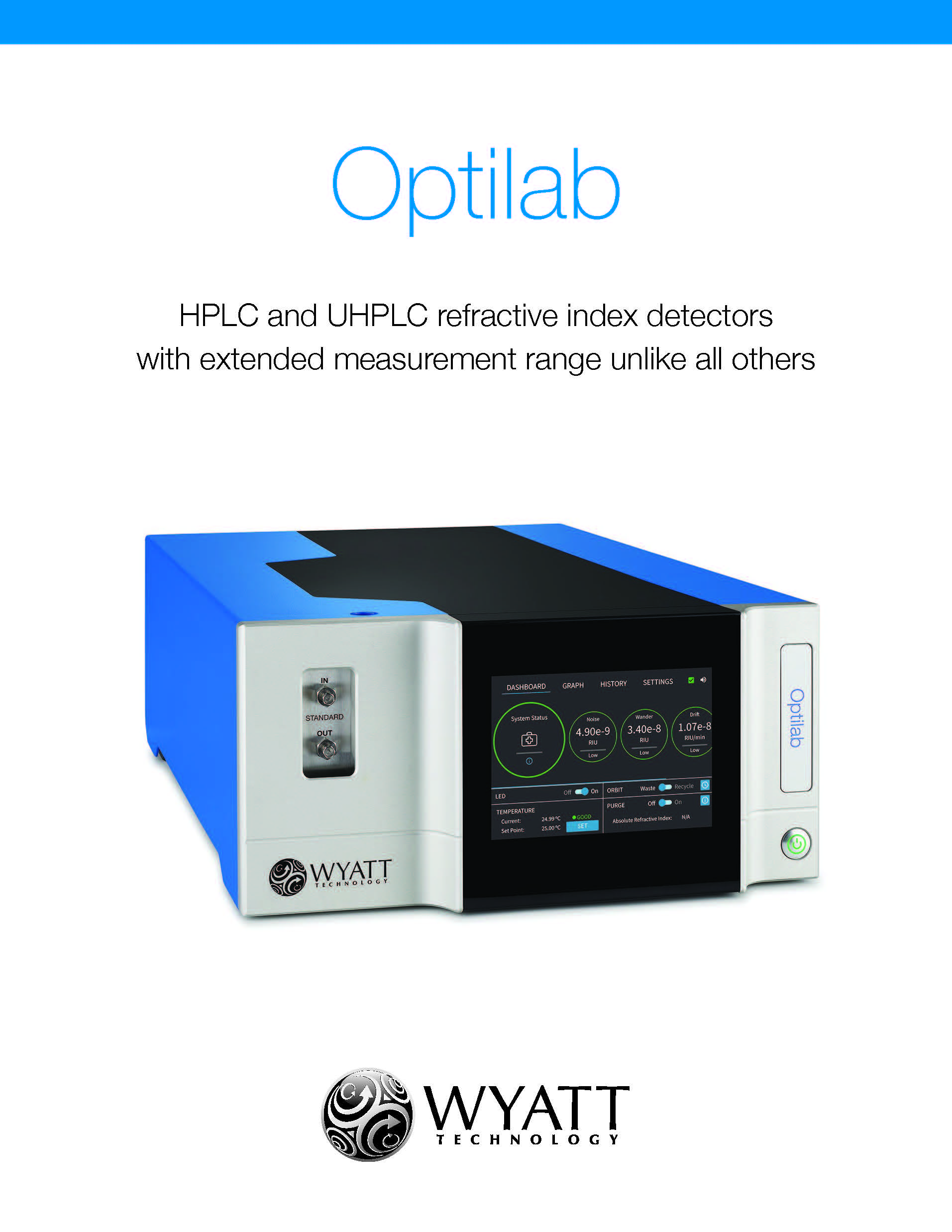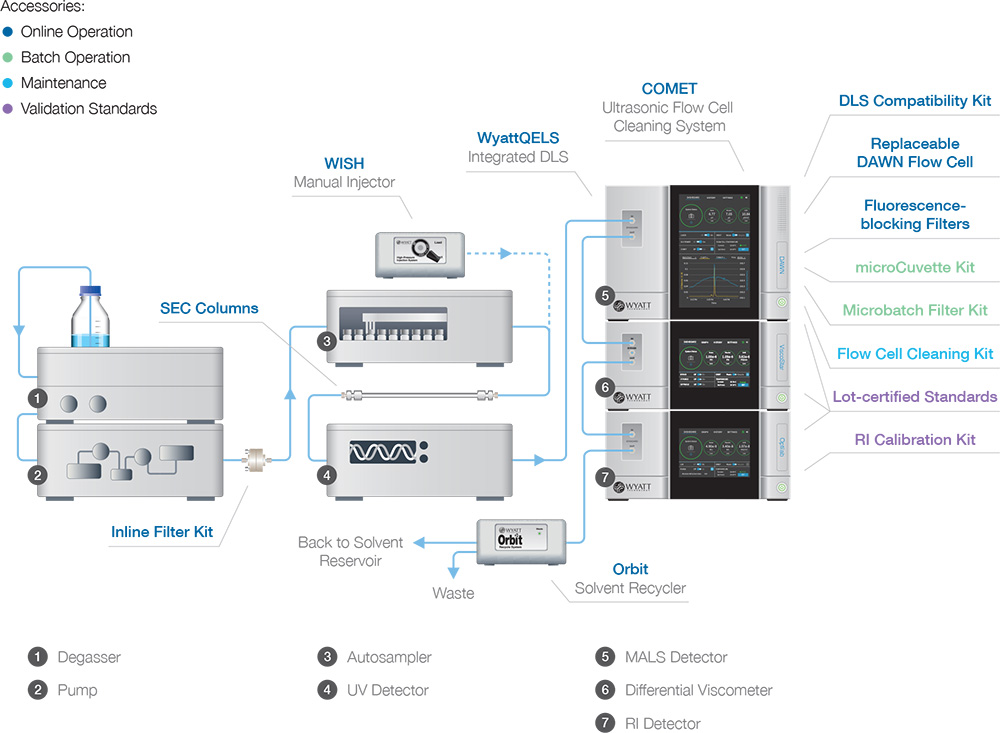Optilab™
Product Overview
Product Description
Brochure
Advanced Technology
On-Line Operation
Batch Operation
Accessories
Specifications
Other Refractive Index Detectors
Publications
Request Info

Universal Detection for Chromatography and FFF Separations
Independent of Chromaphores
Independent of chromaphores or fluorophores, differential Refractive Index (dRI) detectors serve as accurate and versatile concentration detectors in all types of solvents. dRI is part of standard instrumentation for a variety of macromolecular characterization techniques including standard chromatography, SEC-MALS, FFF-MALS and CG-MALS.
Unique dRI Detector
The Optilab is a unique dRI detector for standard HPLC/GPC with 256 times the detection power and 50 times the dynamic range of every other RI detector for chromatography in existence today, making it a valuable addition to any MALS setup.
Using a combination of cutting-edge semiconductor photodiode technology and proprietary computer algorithms, the Optilab achieves an unprecedented combination of sensitivity and range. These features mean that it addresses both standard chromatographic applications and some challenges unique to light scattering measurements such as high concentrations, determination of sample refractive increments (dn/dc) and solvent refractive index.
Key Benefits
- Extraordinary dRI measurement range, -0.0047 to +0.0047 RIU (comparable to 25 mg/mL protein in PBS)
- Highly sensitive, ±7.5 x 10-10 RIU across the entire measurement range
- Measures solvent absolute refractive index, required for MALS calculations
- Measures at the same wavelength as the MALS detector, for maximum accuracy in MALS calculations
- Band broadening < 20 µL preserves SEC resolution
- Temperature range 4 °C to 65 °C for proteins and polymers that require a range of temperatures
- High-resolution, touch-screen front panel displays data graphs and diagnostics, even with the host computer turned off
Unparalleled Features
Even though the Optilab offers a dRI measurement range orders of magnitude beyond that of other dRI detectors, unlike other detectors there are no range or gain settings in the Optilab. The full range of instrument detection is always present, and the full sensitivity exists over the entire range.
The Optilab can also do something no other on-line refractive index detector can: it can measure the absolute refractive index of a solution. In addition, it can measure the dn/dc of a solvent at the same wavelength of light as the light scattering instrument. And just to make sure it can't be matched, you can replace the light source in the Optilab for other wavelengths (e.g., 690, 633, 488, etc.) in just minutes!
The Optilab can go below ambient temperatures as easily as above ambient. No hassle temperature control can be programmed from 4 °C to 65 °C. Compatible with all HPLC systems.
HPLC and UHPLC refractive index detectors with extended measurement range unlike all others
Click here to request a copy of our Optilab brochure.
Revolutionary dRI detection optics
The Optilab incorporates the breakthrough optical design of the award-winning Optilab dRI detector which makes use of a 512-element diode array and proprietary algorithms, instead of the usual bi-cell design, bringing dRI detection into the 21st century. Later Optilab models added improvements in optical stability, temperature control, LED light source intensity and increased on-board computing power in order to enhance sensitivity and extend the temperature range over the Optilab.
Minimal loss of resolution
Each detector downstream of SEC or FFF adds band broadening and dispersion, according to its internal fluidic volume. With a total flow cell volume of only 7.4 µL — 25% less than the leading HPLC refractometers – the Optilab does not impact SEC resolution adversely. This translates into minimized band broadening and better temperature stability.
SEC-MALS and FFF-MALS
An Optilab is generally combined with a DAWN™ or miniDAWN™ MALS detector for analysis of molar mass / molecular weight, conformation and conjugation of macromolecules in solution by means of SEC-MALS or FFF-MALS. It also combines with a ViscoStar™ differential viscometer for analysis of intrinsic viscosity.
General Use
Though its optimal use is in conjunction with MALS analysis, the Optilab can be operated downstream of any standard GPC or HPLC system. While ASTRA™ utilizes its 22+-bit digital signal, it also offers a 18-bit analog output for use with 3rd-party systems, typically when MALS is not utilized.
The Optilab offers an unparalleled dynamic range for use as both an online and batch measurement system. For batch measurement, sample is injected into the instrument (usually by means of a WISH™ Injection Module or Calypso™) in order to measure dn/dc or as part of a CG-MALS interaction analysis.
High Concentration Option
When the primary analysis desired is batch mode, the High Concentration version of the Optilab is optimal since it extends the range of measurement by sevenfold compared to a standard Optilab, while losing only a factor of 2 in sensitivity. The High Concentration Optilab offers measurements up to 180 mg/mL of protein but may still be used in chromatography mode for 99% of all SEC-MALS and FFF-MALS measurements.
| Differential Refractive Index | |
| Standard Optilab | |
| Range (RIU) | -0.0047 to +0.0047 |
| Peak-to-peak noise (RIU)1 | ± 7.5 x 10-10 |
| High Concentration Option | |
| Range (RIU) | -0.0026 to +0.034 |
| Peak-to-peak noise (RIU)1 | ± 1.5 x 10-9 RIU |
| Response Time (User Selectable) | 0.1 to 5 seconds |
| Absolute Refractive Index | |
| Range (RIU) | 1.2 to 1.8 |
| Sensitivity (RIU) | ± 0.002 |
| Fluidics | |
| Band Broadening2 | < 12 μL |
| Fill Volume (inlet tubing + flow cell) | 51.4 μL |
| Outlet tubing (0.030" ID) | 370 μL |
| Pressure | |
| Back pressure created at inlet port (@ 0.5 mL/min H2O, 20 °C) | <22 psi (1.5 bar) |
| Maximum permissible back pressure allowed at outlet port | 30 psi (2 bar) |
| Sample Temperature | |
| Control Range | 4 °C to 65 °C |
| Regulation | ± 0.005 °C |
| Light Source | Optilab: 660 nm; Optilab HC: 660 nm standard, optionally 488 nm, 785 nm or 940 nm |
| Safety Sensors | Vapor and liquid (leak) |
| Electronics | |
| Digital Output | 22+ bits @ 10 Hz |
| Analog Output | ± 10 V or ± 1 V output, 18 bits resolution |
| Computer Interface | Ethernet |
| Front Panel Display | 7" (178 mm), high-resolution, multi-touch display for viewing/setting signals, instrument settings and diagnostics |
| Auxiliary I/O | |
| Inputs | Analog In (16 bits, ± 10 V A/D), Zero dRI, Purge, Recycle In, Autoinject In, Alarm In |
| Outputs | Autoinject Retransmit, Alarm Out, Recycle Out (to switch Orbit™ between waste and recycle) |
| Dimensions | 58 cm (L) x 36 cm (W) x 18 cm (H) |
1Short term peak-to-peak noise is measured per ASTM-E1303-95(2000) using a 2 second collection interval (4 second time constant) for Optilab or a 0.5 sec collection interval (1-sec time constant) for the microOptilab, and temperature set to 25 °C (both).
2Defined as broadening of the peak, measured over full width at half max, flow rate = 0.5 mL/min for Optilab and Optilab HC.
Host PC requirements may be found in Computer Requirements.
Specifications subject to change without notice.
Other Refractive Index Detectors

microOptilab™ - The first RI detector specifically designed for use with all UHPLC systems.


